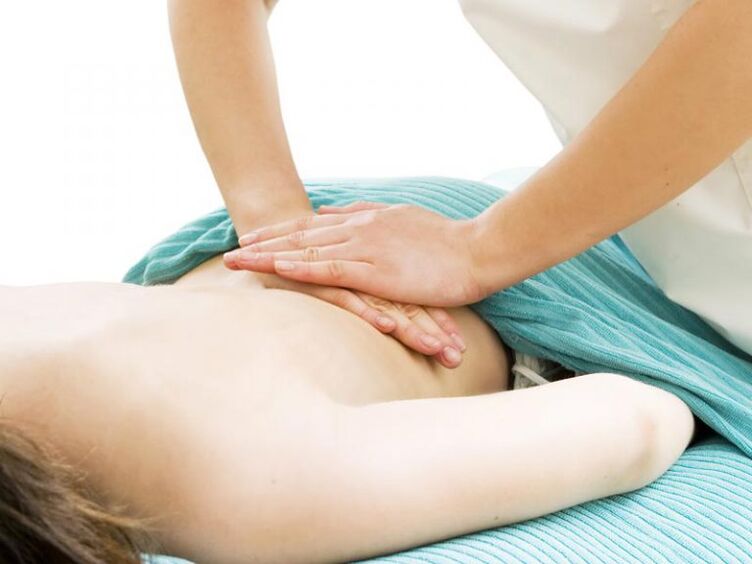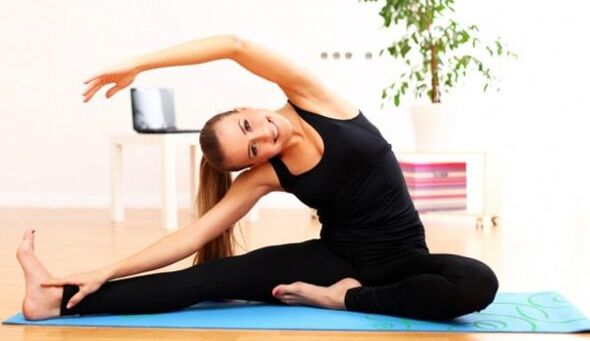Osteochondrosis in the lumbar region is a common disease.This is a consequence of the degenerative process in which the intervertebral disc suffers: tissue nutrition worsens, the disc is thinner, hardens and does not perform the function absorbing shocks.Consequently, the distance between the vertebrae decreases and the ending of the spinal cord and the nerve are pinched, the pain and the dysfunction of the organs occur.
The intervertebral disc is an anatomical disc training that provides the mobility and elasticity of the spine.The disc consists of a pulpoose nucleus surrounded by a fibrous ring.The pulpose nucleus absorbs quickly and gives water, which is important for maintaining the intra-disposted pressure.All degenerative-dystrophic diseases of the spine, which include osteochondrosis, begin with the progressive dehydration of the pulpose nucleus.
Causes of lumbar osteochondosis
Lumbar osteochondosis develops following a certain number of reasons:
- Regular high load in the lower back.At risk, athletes and people forced to lift weights at work.
- A sedentary lifestyle.Without moderate physical activity, the muscular corset is weakening, the blood circulation aggravates and the metabolic processes in the spine slow down.
- Excess weight.The consequences of overweight - an increase in pressure on the spine, the premature wear of the intervertebral discs.
- Moster troubles.With a vrogated back or excessive deviation in the lower back, the back muscles are weak, or vice versa, tense.The load on the spine is distributed unevenly.
- Trauma and spine of microtraums.They can cause sports, especially without appropriate preparation, incorrect weight, bruises, falls, etc.
When lifting weights, the following procedure must be observed:
- squat, right;
- take charge as close as possible to the body;
- When you raise first, you should filter the leg muscles (feet, hips);
- Then pass the press;
- Finally, the muscles of the hands are starting to work.
- Age.Distribution changes in the spine are part of the aging process, but now such a diagnosis is increasingly made on faces of 25 to 30 years and even adolescents.
- Heredity.The violations of the development of the musculoskeletal framework and the low structure of the intervertebral discs can be genetically predetermined.
- Inflammatory spine diseases.Infections and diseases that cause inflammation of the joint joints, changes in its structure and form can cause the development of osteochondrosis.
Other causes causing lumbar osteochondosis:
- Congenital violations or acquired in the structure of the skeleton;
- frequent hypothermia;
- high stress level;
- bad nutrition;
- violation of the day's regime;
- uncomfortable poses for a long time;
- failure in the endocrine system;
- diseases of other organs;
- Bad ecology.
Lumbar osteochondrosis stages
Osteochondrosis of the lumbar column is gradually developing, passing through four stages.
The first step is the start of the degenerative process in the spine.Rare stupid pains in the lower back, which manifests particularly when the lifting of weight or awkward movements is characteristic.
In the 2nd stage, the fibrous ring of the disc is destroyed and the vertebrae are united, the nerve endings of the spinal cord are compressed.The pain becomes hard, even occurs with an ordinary walk.
In the 3rd stage, the fibrous rings are ultimately destroyed, the intervertebral hernies appear.Intensive pain is constantly felt, whatever the load and the nature of the movements.
At the 4th stage, the cartilage is atrophied and the bone tissue of the vertebrae in the lumbar region develops, thus adapting to pain.The lumbar region loses flexibility, it is difficult for the patient to move, disability can occur.
Lumbar osteochondrosis symptoms
Lumbar osteochondosis is slowly developing, in the early stages, its symptoms are weakly expressed, rarely manifest and only after an excessive or atypical load.Therefore, many attach them no importance to them.As a rule, the disease is only diagnosed in the second stage.
Symptoms are divided into following types:
- Lumbalgia - Painful pain in the lumbar region, which constantly lasts.It is improved by inclinations, turns, physical activity and hypothermia.The relief rest on the back, so the patient is forced to be more comfortable.
- Lumbago - Acute and intense pain, as a "change".To protect you, the back muscles are compressed by reflex in a spasm, a person involuntarily takes a safe pose.With any movement, the pain intensifies, radiates towards the organs of the pelvis, the area of the sacrum and the abdomen.If such symptoms are observed, bed rest is recommended.
- Lumbosiciaiahialgia - Pain with propagation to the buttocks, one or both legs.The sensitivity of the lower limbs changes, both in the larger and the smallest direction, according to the spine whose nerve has been pinched.The lower the location of degenerative changes, the more the symptoms will appear on the legs: the mobility of the muscles and the reflexes of the tendons will decrease, the sensations of the cold or the heat, the burn, tingling, numbness appear.
Osteochondrosis is a chronic disease, periodically passing through an acute and subabigal stage.Acute stadium pain can last for several weeks.
During the disease, symptoms can occur in the complex, the following syndromes occur:
- Rook syndrome.The nerve endings (roots) are pressed by the vertebrae, in an area associated with the affected nerve, the pain appears.The body tries to protect the nerve, tends the muscles, changes the posture (biases on the opposite and healthy side).
If the treatment does not start to start treatment over time, after irritation of the roots, their inflammation will follow, accompanied by edema, blood stagnation and even intoxication.The tone of the muscles is reduced, the patient can hardly move.If the spinal cord is compressed, paralysis occurs.
- Ischemic syndrome.These are symptoms associated with circulatory disorders.The pressed arteries cause pain, especially during walking.The whole leg hurts the buttock on the foot, the pelvic organs do not receive appropriate nutrition, accordingly - their function is disturbed.
- Vertebrates syndrome.Previous syndromes lead to the fact that the shape of the spine changes.Due to constant pain and weakened muscles, distortions of the spine appear.
Treatment methods
The treatment of osteochondrosis in the lumbar region must be carried out in depth.The main tasks of treatment:
- Elimination of pain syndrome in the lumbosacral department;
- elimination of muscle tension;
- Elimination of the causes of radicular and ischemic syndromes;
- stimulation of the restorative forces of the body;
- Strengthening the engine device at the bottom of the body.
Drugs
Medicines for the acute phase are designed to relieve the main symptoms: pain, inflammation, tightening of the roots.For these purposes, non-steroidal anti-inflammatory drugs, muscle relaxants, glucocorticoids, a blockage is used.Drug treatment is generally used in combination with other procedures.

Massage
Professional massage is one of the best methods for treating diseases in the spine.It can be done both at the clinic and at home.During massage, tissue nutrition is restored, muscle cramps and pain are maintained.The masseur should have high qualifications because incorrect actions can worsen the patient's condition, especially during exacerbation.
Physiotherapy
Physiotherapeutic procedures contribute to the elimination of pain, the relaxation of the muscles, the expansion of the blood vessels.The most effective procedures: electrophoresis, amplipulse, exposure to UV, phonophoresis, darsonvalization, magnetotherapy, acupuncture, etc.Some devices can be purchased to be used at home.
Medical physical education
The therapy of exercise is prescribed mainly during the period of remission, less often at the acute stage.The exercises are individually selected, taking into account the characteristics of the course of the disease.They are better made in a medical institution under the supervision of a specialist, but it is possible at home.
Traditional medicine
People's remedies help relieve pain and improve blood circulation.Apply various decoctions, infusions, ointments, compresses.Medicinal plants, liner, birch, cladding, sage, plantain and many others are used.There are hundreds of recipes, but you should remember that only a doctor can make recommendations on how to treat osteochondrosis from the lumbar to the house.
Surgical treatment
If other treatment methods have not brought the result and the patient's condition is exacerbated, then surgeon surgery is necessary.During surgery on the spine, the hernia discs are removed and the vertebral plastic is made.
Do not try to choose drugs or exercises by yourself at home, this can lead to unpredictable consequences.
Prevention of lumbar osteochondrosis
So that the unpleasant symptoms of spine problems do not appear during life, certain rules should be observed:

- Prevent a strong load on the back, if there is such a need, use a corset;
- Daily do gymnastics at home or in the gymnasium, leads an active lifestyle;
- Maintain a good posture;
- Walk on foot every day;
- Do not be in a sitting position for a long time;
- During the day, relax periodically lying on your back;
- observe the daily routine;
- abandon smoking and alcohol;
- Eat properly, monitor weight;
- Treat other back diseases over time.
Products that allow us to strengthen bones and prevent the development of spine pathologies:
- Sea fish.
- Olive, linseed oil.
- Natural dairy products.
- Gelatin (as part of the dishes, for example, in a cold or a jelly).
- Cartilage cartilage.
- Fresh fruits, vegetables.
- Green.
- Mineral water.
- Special vitamin-mineral complexes.
Osteochondrosis in the lumbar region can seriously complicate life.Non -reversible changes in the spine will sooner or later cause a feeling of pain and limit mobility.In order not to lose the ability to move freely and work fully, it is important from an early age to engage in rehabilitation and strengthening of the back.If the first symptoms of osteochondrosis appear, by no means a visit to a doctor.Only the qualified and in time provided with assistance will maintain the health of the spine.



































